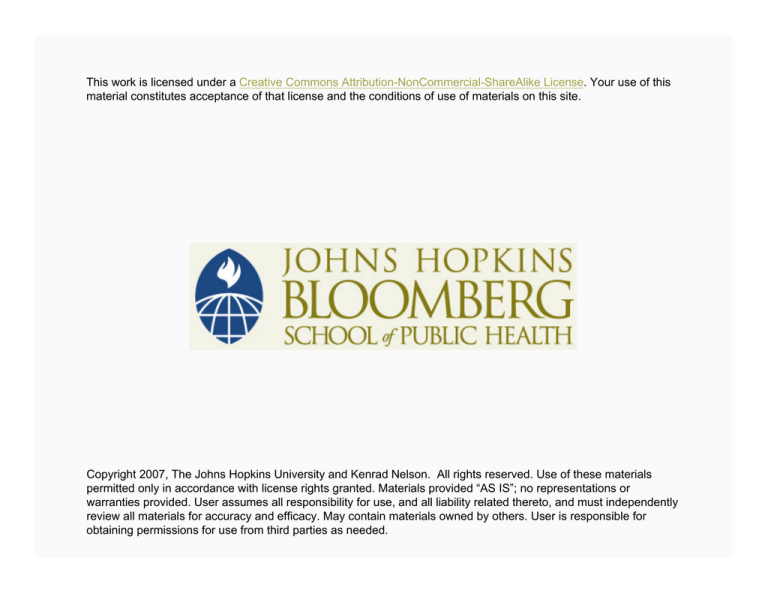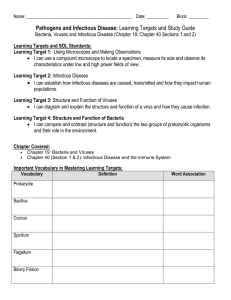
This work is licensed under a Creative Commons Attribution-NonCommercial-ShareAlike License. Your use of this
material constitutes acceptance of that license and the conditions of use of materials on this site.
Copyright 2007, The Johns Hopkins University and Kenrad Nelson. All rights reserved. Use of these materials
permitted only in accordance with license rights granted. Materials provided “AS IS”; no representations or
warranties provided. User assumes all responsibility for use, and all liability related thereto, and must independently
review all materials for accuracy and efficacy. May contain materials owned by others. User is responsible for
obtaining permissions for use from third parties as needed.
Introduction to Infectious Disease Epidemiology
Kenrad Nelson, MD
Johns Hopkins University
Section A
History of Infectious Diseases in the 20th Century
Crude Death Rate* for Infectious Diseases: U.S., 1906–’96
40 states have health
departments
*Per 100,000 population per year
§
American Water Works Association. (1973). Water chlorination principles and practices:
AWWA manual M20. Denver, Colorado.
Adapted by CTLT from Armstrong, G. L., Conn, L. A., Pinner, R. W. (1999). Trends in infectious disease mortality in the United
States during the 20th century. Journal of the American Medical Association, 281, 61–66.
4
Crude Death Rate* for Infectious Diseases: U.S., 1906–’96
First continuous municipal
use of chlorine in water in
U.S.§
*Per 100,000 population per year
§
American Water Works Association. (1973). Water chlorination principles and practices:
AWWA manual M20. Denver, Colorado.
Adapted by CTLT from Armstrong, G. L., Conn, L. A., Pinner, R. W. (1999). Trends in infectious disease mortality in the United
States during the 20th century. Journal of the American Medical Association, 281, 61–66.
5
Crude Death Rate* for Infectious Diseases: U.S., 1906–’96
Influenza pandemic
*Per 100,000 population per year
§
American Water Works Association. (1973). Water chlorination principles and practices:
AWWA manual M20. Denver, Colorado.
Adapted by CTLT from Armstrong, G. L., Conn, L. A., Pinner, R. W. (1999). Trends in infectious disease mortality in the United
States during the 20th century. Journal of the American Medical Association, 281, 61–66.
6
Crude Death Rate* for Infectious Diseases: U.S., 1906–’96
First use of penicillin
Salk vaccine introduced
*Per 100,000 population per year
§
American Water Works Association. (1973). Water chlorination principles and practices:
AWWA manual M20. Denver, Colorado.
Adapted by CTLT from Armstrong, G. L., Conn, L. A., Pinner, R. W. (1999). Trends in infectious disease mortality in the United
States during the 20th century. Journal of the American Medical Association, 281, 61–66.
7
Crude Death Rate* for Infectious Diseases: U.S., 1906–’96
*Per 100,000 population per year
§
American Water Works Association. (1973). Water chlorination principles and practices:
AWWA manual M20. Denver, Colorado.
Adapted by CTLT from Armstrong, G. L., Conn, L. A., Pinner, R. W. (1999). Trends in infectious disease mortality in the United
States during the 20th century. Journal of the American Medical Association, 281, 61–66.
8
10 Leading Causes of U.S. Deaths: 1900 and 1997
The 10 leading causes of death as a percentage of all deaths in the United States, 1900 and 1997
1990
1997
1.
Pneumonia
1.
Heart Disease
2.
Tuberculosis
2.
Cancer
3.
Diarrhea & Enteritis
3.
Stroke
4.
Heart Disease
4.
Chronic Lung Disease
5.
Stroke
5.
Unintentional Injury
6.
Liver Disease
6.
Pneumonia & Influenza
7.
Injuries
7.
Diabetes
8.
Cancer
8.
HIV Infection
9.
Senility
9.
Suicide
10. Diptheria
Source: Morbidity and Mortality Weekly Report, 48(29), 623.
10. Chronic Liver Disease
9
U.S. Death Rates for Common Infectious Diseases
Death Rates for Common Infectious Diseases in the United States in 1900, 1935, and 1970
Mortality rate per 100,000 population
1900
1935
1970
Influenza and pneumonia
202.2
103.9
30.9
Tuberculosis
194.4
55.1
2.6
Gastroenteritis
142.7
14.1
1.3
Diphtheria
40.3
3.1
0.0
Typhoid fever
31.3
2.7
0.0
Measles
13.3
3.1
0.0
Dysentery
12.0
1.9
0.0
Whooping cough
12.0
3.7
0.0
Scarlet fever (including
streptococcal sore throat)
9.6
2.1
0.0
Meningococcal infections
6.8
2.1
0.3
10
Mean Annual Death Rate from Whooping Cough
Children under 15 years of age, England and Wales
It is frequently assumed that
the identification of the
causative organisms and the
development of vaccines
and antibiotics are the
reasons that mortality has
changed, but this is not quite
true for most infectious
diseases.
11
Surgeon General’s Prediction
“ Because infectious diseases have been largely controlled in the
United States, we can now close the book on infectious
diseases.”
— William Stewart, MD
U.S. Surgeon General, 1967
12
Some Recent Epidemics of Emerging Infectious Diseases
13
Trends in Deaths Caused by Infectious Diseases
United States,1980–1992
National Center for Health Statistics underlying and multiple cause-of-death data
14
Trends in Deaths Caused by Infectious Diseases, by Age
United States,1980–1992, by age group
National Center for Health Statistics underlying and multiple cause-of-death data
15
Death Trends Caused by Infectious Disease Syndromes
United States,1980–1992
National Center for Health Statistics underlying and multiple cause-of-death data
16
Section B
Newly Emerging Infections
Trends in Death Rates from Leading Causes, Ages 25–44
Trends in annual rates of death from leading causes of death
among persons 25–44 years old, United States, 1982–1998
18
Some Emerging AIDS-Related Infectious Diseases
1. Pneumocystis carinii
pneumonia
2. Tuberculosis
3. Mycobacterium-avium
complex
4. Kaposi’s sarcoma (HHV-8)
5. HSV-2
6. Cryptosporidium
7. Microsporidium
8. Cryptococcus neoformans
9. Penicillium marneffei
10. Disseminated salmonella
11. Bacillary angiomatosis
(Bartonella henselae)
12. HPV
19
Some Emerging Non-AIDS-Related Infectious Diseases
1.
2.
3.
4.
5.
6.
7.
8.
SARS
West Nile disease
Variant CJD disease
Monkey pox
Ebola and Marburg viruses
Dengue
Influenza H5/N1 (?)
Hanta virus
9. E. Coli O157:H7
10. Antibiotic-resistant
– Pneumococci
– Staph-aureus
– Gonococci
– Salmonella
11. Cryptosporidium
12. Anthrax
20
Chain of SARS Transmission at Hong Kong Hotel, 2003
The 8500 cases and 850 deaths worldwide were related to 1
case. A physician from southern China who checked into a
hotel in Hong Kong was ill with pneumonia and infected 13
other people, probably through airborne transmission.
The 13 infected persons were on their way to other countries
and introduced the epidemic to others upon arrival at their
destinations.
− Canada
− United States
− Ireland
− Thailand
− Singapore
− Vietnam
21
SARS Epidemic Curve in Hong Kong, 2003
22
Epidemic Curve for Beijing SARS Outbreak
23
Factors Leading to Emergence of Infectious Diseases
AIDS
Population growth
Speed and ease of travel
Dam building
Global climate change
Increased antibiotic use for
humans and animals
Encroachment of human
populations on forest
habitats
Industrial commercial
agriculture
War and social disruption
Relocation of animals
Growth of daycare
Aging of the population
Human-animal contact
24
Emerging Infectious Diseases Related to Animal Contact
Emerging Infectious Diseases Related to Direct Contact between Humans and Animals
Disease
Animal
1. HIV-1, LHIV-2
Primates (Africa)
2. Influenza
Water fowl, pigs, chickens (N5/N1)
3. Ebola
Primates (“bush meat”)
4. Marburg
Primate (“bush meat”)
5. Hanta virus
Deer mouse
6. Arena virus
Various rodents
7. Variant CJD
Cattle
8. Cryptosporidia
Cattle
9. Hendra virus
Fruit bats
10. Nipah virus
Pigs, fruit bats
11. SARS
Civet cats
12. Monkey pox
Prairie dogs
25
Emergence of New Infectious Diseases
Over the last 150 years, there have been many global changes that have enhanced the probability of
the emergence of new infectious diseases of humans and animals. This chart depicts three examples
of such trends: the increase in the human population, the increased construction of large dams (over 75
meters high) built in the U.S. (1890–1975), and the decrease in time needed to circle the globe.
26
Cryptosporidium Infection in Milwaukee, 1993
Reported date of the onset of illness in cases of laboratory-confirmed
or clinically defined cryptosporidium infection—
March 1 through April 15, 1993
Note: The clinically defined cases were identified during a telephone survey begun on April 9 of
residents in the area served by Milwaukee Water Works
27
Turbidity of Treated Water in Milwaukee, 1993
Maximal turbidity of treated water in southern water-treatment
plants of the Milwaukee Water Works, March 2 through April
28, 1993
28
Public Health Burden of Foodborne Disease
Each year an estimated 76 million cases
− One in four Americans gets a foodborne illness each year
− One in 1,000 Americans is hospitalized each year
− $6.5 billion in medical and other costs
3.5 million cases, 33,000 hospitalizations, and 1,600 deaths
are caused by the pathogens:
− Salmonella
− E. Coli O157 and other STEC
− Campylobacter
− Listeria
− Toxoplasma
29
Effect of Irradiation on Foods
Free radical oxidants damage DNA of microbes
Nothing becomes radioactive
At doses up to 7.5 kiloGray, minimal change on taste, texture,
nutritional value
Shelf life in general is prolonged (because spoilage organisms
are reduced)
Effective in meats, poultry, grains, produce
Exceptions include:
− Sprout seeds may not sprout well if irradiated
− Oysters die if irradiated, which shortens shelf life
− Egg whites go milky and liquid
− Grapefruit gets mushy
30
Foods Approved for Irradiation in the U.S.
Year
Food
Dose (kGy)
0.2–0.5
Purpose
1963
Wheat flour
1964
White potatoes
1986
Pork
1986
Fruit and vegetables
1.0
Shelf life and insect
control
1986
Herbs and spices
30
Sterilization
1990 (FDA)
Poultry
3.0
Bacterial pathogen
reduction
1992 (USDA)
Poultry
1.5–4.5
Bacterial pathogen
reduction
0.05–0.15
0.3–1.0
Mold control
Inhibit sprouting
Trichinosis
1997 (FDA)
Fresh meat
4.5
Bacterial pathogen
reduction
2000 (USDA)
Fresh meat
4.5
Bacterial pathogen
reduction
31
Number of Outbreak-Related Cases of Escherichia coli
Number of outbreak-related cases of Escherichia coli O157:H7
Reported to the CDC
32
E. Coli Outbreaks Reported to CDC, 1982–1994
Outbreaks of Escherichia coli O157:H7 Reported to the Centers for Disease
Control and Prevention from 1982 to 1994 Inclusive*
No. of outbreaks
No. of individuals
involved
All foods†
Ground beef †
All beef products and milk †
38
22
26
1,541
1,137
1,278
Drinking water– or swimmingassociated
3
276
Person-to-person (no food
identified)
9
243
Unknown
19
274
All outbreaks
69
2,334
Likely vehicle or mode of spread
*Source: CDC surveillance data. Note: data from 1982–1992 are incomplete:
out-breaks without clear sources or sites were not tallied by the CDC
†Some
of these outbreaks also involved person-to-person spread
33
Reservoirs and Modes of Transmission of E. Coli O157:H7
34
Section C
International Infectious Diseases
Global Temperature Anomalies
Climate change can
have a major impact
on the distribution of
infectious disease
vectors like
mosquitoes.
36
Global Carbon Dioxide Emissions
Data collected by Oak Ridge National Laboratory and published in Trends ‘93:
A Compendium of Data on Global Change shows an overall increase in global
carbon dioxide emissions from fossil fuels
37
Aedes aegypti (Mosquito) Is Vector for Yellow Fever
Aedes aegypti control was successfully undertaken for many years until it was discovered that
yellow fever has a sylvatic cycle. That is, in addition to humans, yellow fever also infects other
primates in the jungle. It was therefore decided that this was a futile effort because yellow fever
would persist despite elimination of Aedes aegypti in urban areas.
Source: WHO and PAHO
38
Laboratory-Confirmed DHF* in the Americas
Dengue and dengue hemorrhagic fever (DHF) are also spread by Aedes aegypti. Prior to 1981,
there were no cases in the Western Hemisphere. After the Aedes aegypti eradication program
was stopped, the mosquito reestablished itself and dengue and DHF became a major health
problem throughout Latin America.
39
Leading Causes of Death
53.9 million from all causes worldwide, 1998
Adapted by CTLT from World Health Organization. (1999).
40
Leading Infectious Killers
Millions of deaths, worldwide, all ages, 1998
41
Large Outbreaks
42
Possible Bioterrorism Agents
Bacteria
Viruses
Bacillus anthracis (anthrax)
Variola (small pox)
Vibrio cholera (cholera)
Venezuelan equine encephalomyelitis
Yersinia pestis (plague)
Hemorrhagic fever viruses (e.g.,
Ebola, sin nombre, Hantaan)
Francisella tularensis
(tularemia)
Coxiella burnetii (Q fever)
Toxins
Botulinum
Staphylococcal enterotoxin B
Ricin
T-2 mycotoxins
Source: Walter Reed Army Institute of Research. (1998). Addressing emerging infectious disease threats: A strategic
plan for the Department of Defense. Washington, DC: WRAIR, DOD.
43
Section D
Epidemiologic Principles and Classifications of Infectious
Diseases
Microbiological Classification of Diseases
1.
2.
3.
4.
Bacterial diseases
Viral diseases
Fungal diseases
Parasitic diseases
45
Classification of Microorganisms
Viruses
• RNA–DNA
• RNA viruses genetically
unstable
• Lipid enveloped–nonenveloped
• Solvent-detergent
treatments virucidal only for
enveloped viruses
Fungi
Bacteria
• Gram-positive–gram-negative
• Antibiotic sensitivity differs
• Diagnostic and therapeutic
uses of gram-negative
capsule
Parasites
• Disseminated vs. superficial
• Mold vs. biphasic
• Complete cycle
• Larval migrans
Prions
• Pathogenesis unclear
• Resistant to disinfection
46
A Clinician’s View
Diseases classified according to signs and symptoms
1. Diarrheal diseases
2. Respiratory diseases
3. Cutaneous/soft tissue infection
4. CNS diseases
5. Septicemic diseases
6. Fever of undetermined origin
47
An Epidemiologist’s View
Means of Spread of Infectious Diseases
Contact
• Direct
• Indirect
• Fomites
• Body secretions (blood,
urine, saliva, etc.)
Vector
Airborne
• Small-particle aerosol
Food and/or water
48
Some Infectious Diseases Spread by Contact
1. Sexually transmitted diseases
− Syphilis, gonorrhea, chlamydia, AIDS
2. Staphylococcal infections
3. Streptococcal infections
4. Many nosocomial infections
5. Rhinovirus colds
6. Brucellosis (slaughter house contact)
7. Hepatitis B virus infection
49
Some Important Food- and Waterborne Infections
1.
2.
3.
4.
5.
6.
7.
8.
Salmonellosis
Campylobacter
Shigellosis
Clostridium perfringens food poisoning
Staphylococcal enterotoxin food poisoning
Cholera
Giardiasis
Listeriosis
50
Some Important Airborne Infections
1. Tuberculosis
2. Influenza
3. Childhood Infections
− Measles, mumps, rubella, pertussis
4. Parainfluenza
5. RSV
6. Legionella
51
Measles Transmission
52
Some Important Vectorborne Infections
1. Malaria
2. Viral encephalitis
− SLE, WEE, EE, VE, California virus
3. Schistosomiasis
4. Tularemia
5. Dengue
6. Yellow fever
7. Rocky Mountain spotted fever
8. Leishmaniasis
9. Trypanosomiasis
53
Summer Infection Chains for Western Equine Encephalitis
From Hess, A. D. & Holden, Preston (1958) THE NATURAL HISTORY OF THE ARTHROPOD-BORNE
ENCEPHALITIDES IN THE UNITED STATES. Annals of the New York Academy of Sciences 1958;70:294-311.
54
Reservoirs of Infectious Diseases
1.
2.
3.
4.
Human
Animal (zoonoses)
Soil
Water
55
Some Infectious Diseases with a Human Reservoir
1.
2.
3.
4.
5.
6.
7.
AIDS (HIV infection)
Syphilis
Gonorrhea
Shigellosis
Typhoid fever
Hepatitis-B virus
Herpes simplex virus
56
Some Diseases with an Animal Reservoir (Zoonoses)
1.
2.
3.
4.
5.
6.
7.
Nontyphoidal salmonellosis
Brucellosis
Anthrax
Listeriosis
Viral encephalitis (SLE,WEE, CEE)
Rabies
Plague
57
Some Important Diseases with a Soil Reservoir
1.
2.
3.
4.
5.
Histoplasmosis
Coccidioidomycosis
Blastomycosis
Tetanus
Botulism
58
Some Infectious Diseases with a Water Reservoir
1. Pseudomonas infections
− Sepsis, UTI, “hot tub” folliculitis
2. Legionnaires’ disease
3. Melioidosis
59
Infectious Agents: 3 Important Epidemiologic Properties
1. Infectivity
− The propensity for transmission
− Measured by the secondary attack rate in a household,
school, etc.
2. Pathogenicity
− The propensity for an agent to cause disease or clinical
symptoms
− Measured by the apparent : inapparent infection ratio
3. Virulence
− The propensity for an agent to cause severe disease
− Measured by the case fatality ratio
60
Definitions of Some Relevant Terms
Incubation period
− The period between exposure to the agent and onset of
infection (with symptoms or signs of infection)
Secondary attack rates
− The rates of infection among exposed susceptibles after
exposure to an index case, such as in a household or
school
61
Definitions of Some Relevant Terms (cont.)
Persistent infection
− A chronic infection with continued low-grade survival and
multiplication of the agent
Latent infection
− An infection with no active multiplication of the agent, as
when viral nucleic acid is integrated into the nucleus of a
cell as a provirus. In contrast to a persistent infection, only
the genetic message is present in the host, not viable
organisms.
62
Definitions of Some Relevant Terms (cont.)
Inapparent (or subclinical infection)
− An infection with no clinical symptoms, usually diagnosed
by serological (antibody) response or culture
Immunity
− The capacity of a person when exposed to an infectious
agent to remain free of infection or clinical illness
Herd immunity
− The immunity of a group or community. The resistance of a
group to invasion and spread of an infectious agent, based
upon the resistance to infection of a high proportion of
individual members of the group. The resistance is a
product of the number of susceptibles and the probability
that those who are susceptible will come into contact with
an infected person.
63
Cancer in Developed and Developing Countries
Estimated Number of Cancer Cases (In Thousands)
in Developed and Developing Countries, 1990
Note: A greater proportion of infection-related cancers occur in developing
countries. Additional cancers of the colon, bladder, lung, and other organs may
be directly attributable to infection, but no precise number can be quantified.
64







